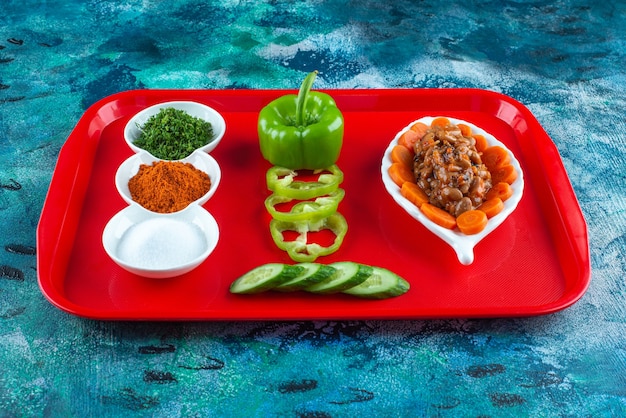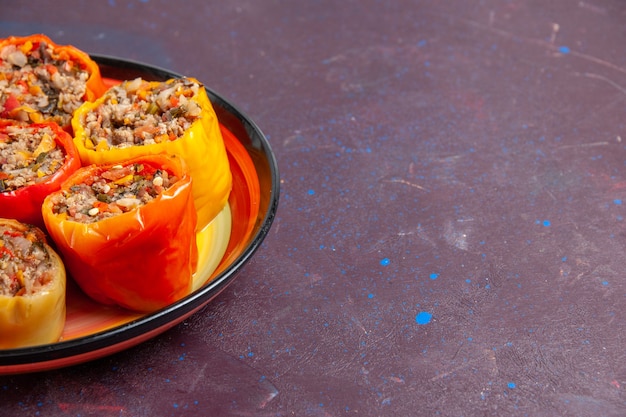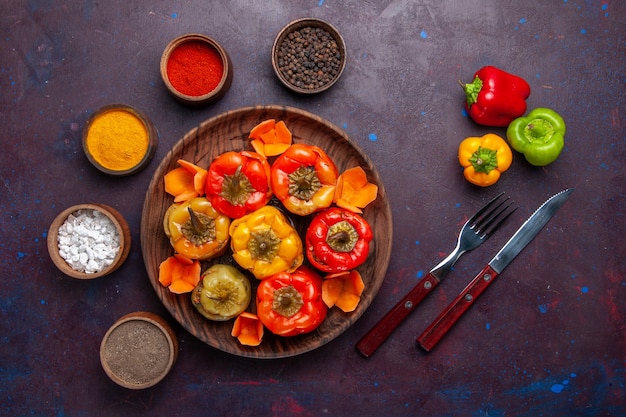Ah, stuffed peppers. They're a real comfort food, aren't they? I mean, there's something so satisfying about a dish that's hearty, flavourful, and a little bit nostalgic. But, let's be honest, getting the cooking times right can feel like a bit of a mystery. You don't want them undercooked, but you also don't want them to turn into mushy blobs, do you? Well, fear not, my fellow food lovers! I'm here to share my hard-earned wisdom, and I'm going to walk you through the whole process, from choosing the perfect pepper to achieving that golden-brown perfection. So, grab your apron, let's get started.
(Part 1) The Basics: Choosing Your Peppers

First things first, let's talk about the stars of the show: the peppers themselves. Now, I'm a classic bell pepper kind of gal, you know, those bright, vibrant colours just make me happy. But, don't feel limited! You can use other peppers, like poblanos or even Anaheim peppers, if you fancy a little kick.
Picking the Perfect Peppers
Here's my guide to picking the best peppers for stuffing:
- Firm and Smooth: You want peppers that feel firm to the touch and have a smooth skin. No blemishes or soft spots, those are signs they've been hanging around for too long.
- Colourful and Vibrant: Look for bright, lively colours. Faded or dull colours usually mean they're past their prime.
- Heavy for its Size: A good pepper should feel heavy for its size. That means it's full of juice and flavour. Give it a gentle squeeze, it shouldn't feel limp or squishy.
(Part 2) Preparing the Peppers

Alright, you've got your peppers, now let's get them ready for their starring role. It's a simple process, but it makes all the difference in the final result.
1. Washing and Cutting
Give those peppers a good wash under cold running water, making sure to get rid of any lingering dirt or debris. Then, carefully cut off the top of the pepper, about an inch or so, and set it aside. This is going to be our little lid later on.
2. Removing the Seeds
This is where it gets a little messy, but trust me, it's worth it. Now you need to scoop out those seeds and membranes. I've tried all sorts of methods – spoons, fingers, even a small knife – and honestly, it comes down to personal preference. Just make sure you get all of them out, because they can make your filling bitter.
3. Blanching (Optional)
Now, here's a little trick I've learned over the years. You can blanch the peppers for a few minutes before stuffing. This helps to soften them up, making them easier to stuff and ensuring they cook evenly. To blanch, bring a pot of water to a rolling boil, then gently lower the peppers into the water for about 1-2 minutes. Immediately transfer them to an ice bath to stop the cooking process. This is a good option for thicker-walled peppers, like poblanos or Anaheims.
(Part 3) Creating the Filling

Alright, this is the fun part! The possibilities for fillings are practically endless. I'm going to give you a few ideas to get you started, but feel free to experiment and get creative.
Traditional Ground Meat Filling
This is a classic for a reason. It's hearty, comforting, and always a crowd-pleaser.
- Brown some ground beef or pork in a pan over medium heat. Drain off any excess fat.
- Add chopped onions, garlic, and your favourite spices, like cumin, paprika, and chili powder. I like to add a pinch of cayenne pepper for a bit of heat.
- Mix in some cooked rice, tomato paste, and tomato sauce. I find using a good quality tomato sauce really makes a difference in flavour.
- Season with salt and pepper to taste. Don't be afraid to add a little extra salt, it brings out all the flavours.
Vegetarian Filling
Don't worry, meat-free eaters, this is for you! It's packed with flavour and protein.
- Sauteed mushrooms, onions, and peppers with herbs like thyme and oregano. I like to use a combination of brown and cremini mushrooms for different textures and flavours.
- Add cooked quinoa, lentils, or beans for a protein punch. I find that black beans or lentils work really well in this filling.
- Use tomato sauce, vegetable broth, and your favourite spices to bring everything together. A little bit of smoked paprika adds a smoky depth to the filling.
Cheese and rice filling
This one is a bit lighter, perfect for a quick and easy meal.
- Mix cooked rice with grated cheese, herbs like parsley and chives, and a touch of cream or sour cream. I love to use a mixture of cheddar and mozzarella cheese, but you can use your favourites.
- You can also add chopped vegetables like spinach or mushrooms. Spinach adds a nice freshness to the filling.
(Part 4) Stuffing the Peppers
Here we are, the moment of truth!
1. Preheating the Oven
First, preheat your oven to 375°F (190°C). This will ensure even cooking and that lovely golden-brown colour.
2. Stuffing the Peppers
Now, carefully stuff the peppers with your chosen filling. Don't pack it in too tightly, leave some room for expansion. I find using a spoon is the easiest way to stuff them, but you can also use your hands if you prefer.
3. Covering the Peppers
Once they're stuffed, place the pepper tops back on. You can use toothpicks to secure them in place, or just let them rest on top.
(Part 5) Baking the Stuffed Peppers
Alright, almost there!
1. Baking Time
Place the stuffed peppers in a baking dish. Pour a little bit of broth or water into the bottom of the dish to keep the peppers moist. Cover the dish with foil and bake for 30-40 minutes. This will help to steam the peppers and cook the filling through. I often use chicken broth, as it adds a bit of extra flavour.
2. Uncovering and Broiling (Optional)
After 30-40 minutes, remove the foil and continue baking for an additional 10-15 minutes, or until the peppers are tender and the filling is heated through. For that extra crispy finish, you can broil the peppers for a few minutes at the end. Just watch them closely, they can burn quickly!
(Part 6) Cooking Times: A Handy Table
Now, let's talk about cooking times. I know every oven is different, so I've put together a handy table to help you out.
| Pepper Type | Size (Approx.) | Baking Time (Covered) | Baking Time (Uncovered) |
|---|---|---|---|
| Bell Pepper (Green) | Medium | 30-35 minutes | 10-15 minutes |
| Bell Pepper (Red, Yellow, Orange) | Medium | 35-40 minutes | 10-15 minutes |
| Poblano Pepper | Medium | 40-45 minutes | 10-15 minutes |
| Anaheim Pepper | Medium | 40-45 minutes | 10-15 minutes |
Keep in mind that these are just estimates. It's always a good idea to check for doneness by inserting a fork. The pepper should be tender and the filling should be heated through. If you're using thicker-walled peppers, they might need a bit longer.
(Part 7) Tips for Success
Here are some extra tips I've learned through trial and error:
- Pre-cook the rice: This will ensure that the rice is cooked through and prevent it from becoming mushy. I usually cook the rice separately and let it cool slightly before adding it to the filling.
- Don't overstuff: Leave some space for the filling to expand. Overstuffing can cause the peppers to burst open.
- Use a baking dish with a lid: This will help to trap the steam and keep the peppers moist. If you don't have a lid, you can cover the dish with foil.
- Add some broth or water to the bottom of the dish: This will help to prevent the peppers from drying out.
- Check for doneness: Use a fork to check if the peppers are tender and the filling is heated through. If the filling is still cold, bake the peppers for a few more minutes.
(Part 8) Serving and Enjoying
Finally, it's time to enjoy your culinary masterpiece!
Serving Suggestions
Stuffed peppers are delicious on their own, but they pair well with a variety of sides. Here are a few of my favourites:
- Salad: A fresh salad with mixed greens, tomatoes, cucumbers, and a vinaigrette dressing is a classic pairing and provides a nice contrast to the richness of the stuffed peppers.
- Roasted Vegetables: roasted broccoli, asparagus, or carrots make a tasty and healthy accompaniment. I often roast them with a little olive oil, salt, and pepper.
- Bread: A slice of crusty bread or a warm roll is perfect for soaking up any extra sauce.
Storing Leftovers
If you have any leftovers (unlikely, but you never know!), store them in an airtight container in the refrigerator for up to 3 days. You can reheat them in the microwave or oven. I prefer to reheat them in the oven, as this helps to keep them moist and prevents them from becoming too dry.
(Part 9) FAQs
Here are some questions I've been asked about stuffed peppers over the years:
1. What's the best way to reheat stuffed peppers?
As I mentioned, I prefer to reheat them in the oven. Just place them in a baking dish and bake them at 350°F (175°C) for about 15-20 minutes, or until heated through. You can also reheat them in the microwave, but they may become a bit rubbery.
2. Can I freeze stuffed peppers?
You can freeze them, but it's best to freeze them before baking. Simply assemble the stuffed peppers, wrap them individually in plastic wrap, and then place them in a freezer-safe bag. They can be frozen for up to 3 months. To thaw, simply place the frozen peppers in the refrigerator overnight. Then, you can bake them from frozen, adding an extra 10-15 minutes to the baking time.
3. What are some variations for stuffed peppers?
Oh, the possibilities are endless! You can use different types of peppers, fillings, and toppings to create your own unique dish. For example, you could try using sweet potato, quinoa, or black beans in your filling, or add some cheese, sour cream, or salsa on top. I've even experimented with using crumbled bacon or chorizo in the filling for a little extra flavour.
4. Can I use other vegetables instead of peppers?
Absolutely! You can use other vegetables like zucchini, squash, or even mushrooms to make your own stuffed vegetable dish. Just follow similar steps for preparing and baking, adjusting the cooking time as needed. I've even used bell pepper halves to create a stuffed vegetable medley.
5. How do I know when the peppers are done?
The peppers should be tender and the filling should be heated through. You can check the doneness by inserting a fork into the pepper. If the fork slides in easily and the filling is no longer cold, the peppers are done. If the filling is still cold, bake the peppers for a few more minutes.
And there you have it! My guide to creating perfect stuffed peppers. I hope it's helped you gain confidence in the kitchen. Go forth and experiment, my fellow food lovers! And remember, if you ever have any questions or need a little encouragement, don't hesitate to ask. Happy cooking!
Everyone is watching

Prime Rib Roast Cooking Time Chart: Per Pound Guide
Cooking TipsPrime rib roast. Just the name conjures images of lavish dinners, crackling fires, and hearty laughter. It’s ...

How Long to Bake Potatoes in the Oven (Perfect Every Time)
Cooking TipsBaked potatoes are a staple in my kitchen. They're incredibly versatile, delicious, and surprisingly easy to m...

Perfect Rice Every Time: The Ultimate Guide to Cooking Rice
Cooking TipsAs a self-proclaimed foodie, I've always been a bit obsessed with rice. It's the foundation of countless cuisi...

The Ultimate Guide to Cooking Asparagus: Tips, Techniques, and Recipes
Cooking TipsAsparagus. The mere mention of this spring delicacy conjures up images of vibrant green spears, crisp and burs...

Ultimate Guide to Cooking the Perfect Thanksgiving Turkey
Cooking TipsThanksgiving. Just the word conjures up images of overflowing tables laden with delicious food, the scent of r...
